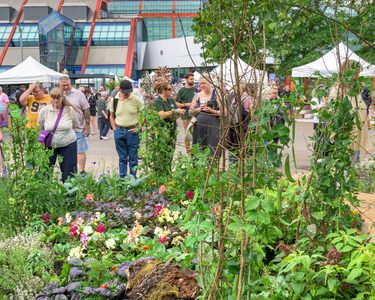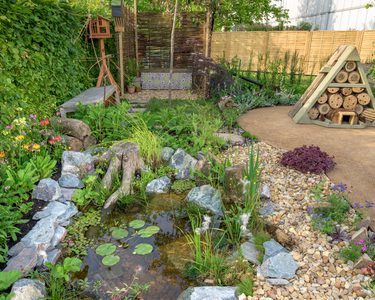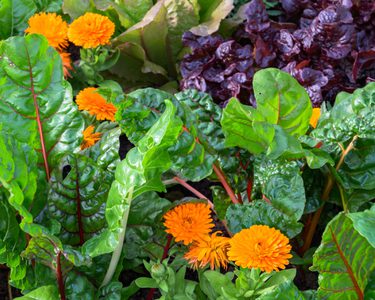Chris Collins on…show garden takeaways

June was a big month for our organisation as we pulled out all the stops to create the EcoTalk ‘Rooted in Nature’ show garden at Gardeners’ World Live. It was a delight for head gardener Emma and I, who designed the garden, that we received a Silver Merit award for all the team’s hard work!
It was a hard graft to build, and we battled with rock-hard soil, but the camaraderie created around a project like this gives the whole Garden Organic team a lift. And it was great to show how easy it is to combine nature and food in a beautiful way that feeds us - but at the same time supports our all-important wildlife.
Key elements of our show garden
Key components included a wildlife pond, built by the brilliant Wild Water Ponds team. The skills level to create this beautiful aquatic habitat was quite breathtaking and when it was finished it looked like it had been there for years rather than just a few days!
Montage planting of both edibles and pollinator friendly plants proved a big hit with the public as many people hadn’t considered growing them together. And visitors loved the multitude of provisions for wildlife within the space that included hoverfly lagoons, a hibernaculum, frog rocks, bat boxes and bird boxes – many of which were made from recycled materials.
The garden design also showed how functional elements such as seating and compost bins can be incorporated in an attractive way. Both of these included planting pockets and habitats to double their usefulness in the garden – great if you only have a small space. Supporting up to 2,000 different life forms, a compost bin is a small ecosystem in its own tight and essential for improving your garden’s soil health.

Montage planting of both edibles and pollinator friendly plants proved a big hit with the public as many people hadn’t considered growing them together. And visitors loved the multitude of provisions for wildlife within the space that included hoverfly lagoons, a hibernaculum, frog rocks, bat boxes and bird boxes – many of which were made from recycled materials.
The garden design also showed how functional elements such as seating and compost bins can be incorporated in an attractive way. Both of these included planting pockets and habitats to double their usefulness in the garden – great if you only have a small space. Supporting up to 2,000 different life forms, a compost bin is a small ecosystem in its own right and essential for improving your garden’s soil health.

The show itself was an incredible experience for the GO team with very positive feedback and praise for the garden and its features. Above all, we wanted to show how affordable and easy to achieve many of the ideas were, so visitors could take them away and use them in their own gardens.
Everything from the show garden was reused and relocated after the event, so nothing was wasted. I really hope you got to see it and enjoy it - but we’ve attached a few photos to this blog so you can see for yourself… and some ideas below for your own garden.
Five ways to combine food and nature in your garden
1. Mix flowers with your veg
An attractive way to bring in vital pollinators while reducing the need for pesticides, is to combine rows or containers of vegetables with flowers. Try Calendula and cabbage to attract hoverflies and ladybirds, which will help control brassica-loving cabbage white caterpillars. Or nasturtiums to pull blackfly away from beans.
2. Fill your garden with habitats. Logs drilled with bee holes, strategically placed rocks for sunbathing, and pots or bowls filled with water for drinking and egg-laying, are all easy ways to attract more insects to your garden.
3. Dip into forest gardening. This food production system emulates what happens naturally in a woodland system. A typical example would be a large fruit tree at canopy level, a layer of currants in the understorey, an herbaceous level of ground cover plants such as strawberries, and then roots.
4. Grow an herb hedge. Tightly clipped rosemary, bay or sage can make a lovely low-growing boundary around your veg beds, which is fragrant and edible as well as attracting bees and butterflies.
5. Build a pond. A veg patch pond can provide shelter, drink, and food for wildlife – and frogs are brilliant at mopping up slugs and snails among your crops. Find out how to build one here - or consider making a mini version in a trug. As long as you add steps for wildlife to get in and out, your pond can be any size.